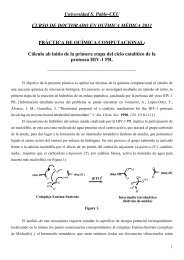Inhibidores de la Bomba de Protones: OMEPRAZOL Y ...
Inhibidores de la Bomba de Protones: OMEPRAZOL Y ...
Inhibidores de la Bomba de Protones: OMEPRAZOL Y ...
You also want an ePaper? Increase the reach of your titles
YUMPU automatically turns print PDFs into web optimized ePapers that Google loves.
Universida<strong>de</strong>s <strong>de</strong> Alcalá, Complutense y San Pablo CEU<br />
Doctorado Interuniversitario QUIMICA MEDICA<br />
ESTRATEGIAS EN<br />
SINTESIS DE FARMACOS<br />
INHIBIDORES DE LA BOMBA DE PROTONES:<br />
<strong>OMEPRAZOL</strong> Y ES<strong>OMEPRAZOL</strong> (Junio 2011)<br />
Mª LUISA IZQUIERDO CEINOS<br />
1
<strong>Inhibidores</strong> <strong>de</strong> <strong>la</strong> <strong>Bomba</strong> <strong>de</strong> <strong>Protones</strong>: <strong>OMEPRAZOL</strong> Y ES<strong>OMEPRAZOL</strong><br />
El ácido gástrico, HCl, se produce en <strong>la</strong>s célu<strong>la</strong>s parietales <strong>de</strong> <strong>la</strong> mucosa gástrica.<br />
El medio ácido <strong>de</strong>l estómago es esencial en <strong>la</strong> digestión <strong>de</strong> los alimentos para:<br />
<strong>de</strong>snaturalizar <strong>la</strong>s proteínas<br />
activar el pepsinógeno a pepsina para que se produzca <strong>la</strong> proteolisis (rotura en<strong>la</strong>ces<br />
peptídicos en <strong>la</strong>s proteinas)<br />
y previene <strong>de</strong> infecciones puesto que muchas bacterias ingeridas en <strong>la</strong> alimentación no sobreviven<br />
a pH ácido<br />
www.mednote.co.kr/ images/parietalcell.jpg<br />
www.mfi.ku.dk/ppaulev/ chapter22/images/22-9.jpg<br />
2
<strong>Inhibidores</strong> <strong>de</strong> <strong>la</strong> <strong>Bomba</strong> <strong>de</strong> <strong>Protones</strong>: <strong>OMEPRAZOL</strong> Y ES<strong>OMEPRAZOL</strong><br />
La secreción <strong>de</strong> ácido gástrico tiene lugar en varios pasos.<br />
H + y Cl ‾ se segregan por separado en <strong>la</strong>s CÉLULAS PARIETALES, se combinan para formar HCl en los<br />
CANALÍCULOS y a través <strong>de</strong> ellos se segrega al lumen <strong>de</strong>l estómago<br />
www.mfi.ku.dk/ppaulev/ chapter22/images/22-10.jpg<br />
www.nurseminerva.co.uk/ images/acidcell.jpg<br />
Indice <strong>de</strong> <strong>la</strong> Sección <strong>de</strong> Fisiología<br />
http://www.iqb.es/cbasicas/fisio/toc03.htm<br />
3
<strong>Inhibidores</strong> <strong>de</strong> <strong>la</strong> <strong>Bomba</strong> <strong>de</strong> <strong>Protones</strong>: <strong>OMEPRAZOL</strong> Y ES<strong>OMEPRAZOL</strong><br />
La producción <strong>de</strong> ácido gástrico se regu<strong>la</strong> por el sistema nervioso autónomo y varias hormonas:<br />
El sistema nervioso parasimpático, vía el nervio vago,<br />
y <strong>la</strong> GASTRINA estimu<strong>la</strong>n <strong>la</strong> producción <strong>de</strong> HCl actuando<br />
directamente sobre <strong>la</strong>s célu<strong>la</strong>s parietales y estimu<strong>la</strong>ndo <strong>la</strong><br />
secreción <strong>de</strong> HISTAMINA por <strong>la</strong>s célu<strong>la</strong>s ECL.<br />
En <strong>la</strong> producción <strong>de</strong> ácido gastrico están implicados cuatro<br />
tipos <strong>de</strong> célu<strong>la</strong>s:<br />
http://en.wikipedia.org<br />
Célu<strong>la</strong>s parietales<br />
Célu<strong>la</strong>s G<br />
Célu<strong>la</strong>s D<br />
EnteroChoromaffine-Like cells (ECL)<br />
4
<strong>Inhibidores</strong> <strong>de</strong> <strong>la</strong> <strong>Bomba</strong> <strong>de</strong> <strong>Protones</strong>: <strong>OMEPRAZOL</strong> Y ES<strong>OMEPRAZOL</strong><br />
Una secreción excesiva <strong>de</strong> ácido gástrico daña <strong>la</strong> mucosa <strong>de</strong>l tracto gastrointestinal produciendo úlceras<br />
<strong>de</strong> estómago y duo<strong>de</strong>no principalmente.<br />
La secreción <strong>de</strong> ácido gástrico se estimu<strong>la</strong> al menos<br />
por tres mecanismos:<br />
Histamina<br />
Acetilcolina y<br />
Gastrina<br />
Para evitar el exceso <strong>de</strong> HCl se utilizan dos tipos <strong>de</strong> fármacos: f rmacos:<br />
<strong>Inhibidores</strong> <strong>de</strong> <strong>la</strong> Producción Producci n <strong>de</strong> Ácido cido (Histamina,<br />
Acetilcolina y Gastrina)<br />
Sales Antiácido Anti cido tales como: CaCO 3, , NaHCO 3 y AlPO 4<br />
que actúan act an por neutralización<br />
neutralizaci n ácido cido-base base<br />
medweb.bham.ac.uk/.../ GIT/GastrinAction.gif<br />
5
<strong>Inhibidores</strong> <strong>de</strong> <strong>la</strong> <strong>Bomba</strong> <strong>de</strong> <strong>Protones</strong>: <strong>OMEPRAZOL</strong> Y ES<strong>OMEPRAZOL</strong><br />
La inhibición <strong>de</strong> los receptores H 2 <strong>de</strong> histamina ha sido durante muchos años (hasta 1977) el área <strong>de</strong><br />
mayor aceptación terapéutica y <strong>la</strong> industria farmacéutica ha <strong>de</strong>sarrol<strong>la</strong>do numerosos fármacos como<br />
antagonistas H 2 ; los cuatro <strong>de</strong> mayor presencia en el mercado son:<br />
N<br />
CIMETIDINA<br />
RANITIDINA<br />
FAMOTIDINA<br />
NIZATIDINA<br />
N<br />
CH 3 C<br />
S<br />
N N CH 3<br />
H H H<br />
N<br />
CIMETIDINA<br />
(Tagamet®)<br />
SK&F (GSK)<br />
6
<strong>Inhibidores</strong> <strong>de</strong> <strong>la</strong> <strong>Bomba</strong> <strong>de</strong> <strong>Protones</strong>: <strong>OMEPRAZOL</strong> Y ES<strong>OMEPRAZOL</strong><br />
C<br />
H 3<br />
C<br />
H 3<br />
C<br />
H 3<br />
CH 3<br />
N<br />
CH 3<br />
CH 3<br />
N<br />
N<br />
S<br />
S<br />
O<br />
N<br />
N<br />
S<br />
S<br />
S<br />
NO 2<br />
N N CH 3<br />
H H<br />
N N CH 3<br />
H H<br />
NO 2<br />
N N CH 3<br />
H H<br />
NO 2<br />
RANITIDINA<br />
(Zantac®)<br />
FAMOTIDINA<br />
(Pepcid®)<br />
NIZATIDINA<br />
7
<strong>Inhibidores</strong> <strong>de</strong> <strong>la</strong> <strong>Bomba</strong> <strong>de</strong> <strong>Protones</strong>: <strong>OMEPRAZOL</strong> Y ES<strong>OMEPRAZOL</strong><br />
En 1977 se <strong>de</strong>scubrieron unos agentes que eliminaban <strong>la</strong> secreción <strong>de</strong> ácido gastrico por inhibición<br />
específica <strong>de</strong> <strong>la</strong> enzima A<strong>de</strong>nosíntrifosfatasa H + /K +<br />
La ATPasa H + /K + es <strong>la</strong> BOMBA DE PROTONES <strong>de</strong>l estómago y por tanto juega un papel fundamental<br />
en el contenido <strong>de</strong> ácido gástrico en el estómago<br />
La ATPasa H + /K + transporta iones H + <strong>de</strong>s<strong>de</strong> el citop<strong>la</strong>sma <strong>de</strong> <strong>la</strong>s célu<strong>la</strong>s parietales al lumen <strong>de</strong>l estómago<br />
intercambiándolos por iones K + y lo hace en contra <strong>de</strong> gradiente utilizando energía <strong>de</strong> <strong>la</strong> hidrólisis <strong>de</strong>l ATP<br />
fig.cox.miami.edu/.../ 150/memb/electrogenic.jpg<br />
8
<strong>Inhibidores</strong> <strong>de</strong> <strong>la</strong> <strong>Bomba</strong> <strong>de</strong> <strong>Protones</strong>: <strong>OMEPRAZOL</strong> Y ES<strong>OMEPRAZOL</strong><br />
Los INHIBIDORES DE LA BOMBA DE PROTONES (PPIs) y áctúan en el paso final <strong>de</strong> <strong>la</strong> producción <strong>de</strong><br />
ácido uniéndose irreversiblemente a <strong>la</strong> ATPasa H + /K + y son más efectivos que los ANTAGONISTAS H 2<br />
en <strong>la</strong> reducción <strong>de</strong> <strong>la</strong> secreción gástrica<br />
Los PPIs se administran en una forma inactiva neutra. Esta forma lipofílica les permite atravesar <strong>la</strong><br />
membrana celu<strong>la</strong>r y llegar a los compartimentos intracelu<strong>la</strong>res: Canalículos <strong>de</strong> <strong>la</strong>s célu<strong>la</strong>s parietales<br />
don<strong>de</strong> se encuentran con un pH ácido que les transforma en una forma protonada activa que se une<br />
irreversiblemente a <strong>la</strong> ATPasa H + /K + inhibiendo su acción<br />
pathology2.jhu.edu/ beweb/images/ppi.gif<br />
9
<strong>Inhibidores</strong> <strong>de</strong> <strong>la</strong> <strong>Bomba</strong> <strong>de</strong> <strong>Protones</strong>: <strong>OMEPRAZOL</strong> Y ES<strong>OMEPRAZOL</strong><br />
Los PPIs son los fármacos <strong>de</strong> mayores ventas a esca<strong>la</strong> mundial. Existen 5 PPIs en uso clínico:<br />
<strong>OMEPRAZOL</strong><br />
LANSOPRAZOL<br />
ES<strong>OMEPRAZOL</strong><br />
PANTOPRAZOL<br />
RABEPRAZOL<br />
Todos poseen un esqueleto <strong>de</strong> piridilmetilsulfinilimidazol<br />
Los PPIs están indicados fundamentalmente en:<br />
El tratamiento profiláctico <strong>de</strong> ulceras gastrointestinales benignas y duo<strong>de</strong>nales<br />
La prevención <strong>de</strong> <strong>la</strong>s úlceras gastrointestinales y duo<strong>de</strong>nales en pacientes <strong>de</strong> riesgo tratados<br />
por AINEs<br />
El síndrome <strong>de</strong> Zollinger Ellison<br />
La enfermedad por reflujo gastreesofágico (ERGE)<br />
El tratamiento <strong>de</strong> <strong>la</strong> ulcera gastrointestinal y duo<strong>de</strong>nal asociada a Helicobacter Pylori<br />
N<br />
O<br />
S<br />
H<br />
N<br />
N<br />
10
<strong>Inhibidores</strong> <strong>de</strong> <strong>la</strong> <strong>Bomba</strong> <strong>de</strong> <strong>Protones</strong>: <strong>OMEPRAZOL</strong> Y ES<strong>OMEPRAZOL</strong><br />
The Nobel Prize in<br />
Physiology or Medicine 2005<br />
"for their discovery of the bacterium Helicobacter pylori and its<br />
role in gastritis and peptic ulcer disease"<br />
Barry J. Marshall<br />
1/2 of the prize<br />
Australia<br />
NHMRC Helicobacter pylori Research<br />
Laboratory, QEII Medical Centre;<br />
University of Western Australia<br />
Ned<strong>la</strong>nds, Australia<br />
b. 1951<br />
J. Robin Warren<br />
1/2 of the prize<br />
Australia<br />
Perth, Australia<br />
b. 1937<br />
11
<strong>Inhibidores</strong> <strong>de</strong> <strong>la</strong> <strong>Bomba</strong> <strong>de</strong> <strong>Protones</strong>: <strong>OMEPRAZOL</strong> Y ES<strong>OMEPRAZOL</strong><br />
http://nobelprize.org/medicine/<strong>la</strong>ureates/2005/in<strong>de</strong>x.html<br />
12
<strong>Inhibidores</strong> <strong>de</strong> <strong>la</strong> <strong>Bomba</strong> <strong>de</strong> <strong>Protones</strong>: <strong>OMEPRAZOL</strong> Y ES<strong>OMEPRAZOL</strong><br />
http://nobelprize.org/medicine/<strong>la</strong>ureates/2005/illpres/2_helicobacter_pylori.html<br />
13
<strong>Inhibidores</strong> <strong>de</strong> <strong>la</strong> <strong>Bomba</strong> <strong>de</strong> <strong>Protones</strong>: <strong>OMEPRAZOL</strong> Y ES<strong>OMEPRAZOL</strong><br />
http://nobelprize.org/medicine/<strong>la</strong>ureates/2005/illpres/3_chronic.html<br />
14
<strong>Inhibidores</strong> <strong>de</strong> <strong>la</strong> <strong>Bomba</strong> <strong>de</strong> <strong>Protones</strong>: <strong>OMEPRAZOL</strong> Y ES<strong>OMEPRAZOL</strong><br />
http://nobelprize.org/medicine/<strong>la</strong>ureates/2005/illpres/4_lifelong.html<br />
15
<strong>Inhibidores</strong> <strong>de</strong> <strong>la</strong> <strong>Bomba</strong> <strong>de</strong> <strong>Protones</strong>: <strong>OMEPRAZOL</strong> Y ES<strong>OMEPRAZOL</strong><br />
http://nobelprize.org/medicine/<strong>la</strong>ureates/2005/illpres/5_mechanisms.html<br />
16
<strong>Inhibidores</strong> <strong>de</strong> <strong>la</strong> <strong>Bomba</strong> <strong>de</strong> <strong>Protones</strong>: <strong>OMEPRAZOL</strong> Y ES<strong>OMEPRAZOL</strong><br />
http://nobelprize.org/medicine/<strong>la</strong>ureates/2005/illpres/6_discovery.html<br />
17
<strong>Inhibidores</strong> <strong>de</strong> <strong>la</strong> <strong>Bomba</strong> <strong>de</strong> <strong>Protones</strong>: <strong>OMEPRAZOL</strong> Y ES<strong>OMEPRAZOL</strong><br />
http://nobelprize.org/medicine/<strong>la</strong>ureates/2005/illpres/7_link.html<br />
PPIs<br />
ANTIBIÓTICOS<br />
18
<strong>Inhibidores</strong> <strong>de</strong> <strong>la</strong> <strong>Bomba</strong> <strong>de</strong> <strong>Protones</strong>: <strong>OMEPRAZOL</strong> Y ES<strong>OMEPRAZOL</strong><br />
<strong>OMEPRAZOL</strong>:<br />
Losec®, Prilosec®<br />
O N<br />
N S<br />
Me N<br />
OMe<br />
MeO<br />
Me<br />
5-Metoxi-2-[(4-metoxi-3,5-dimetilpiridin-2-il)metilsulfinil]<br />
-1H-benzimidazol<br />
H<br />
El <strong>OMEPRAZOL</strong> se introdujo en el mercado<br />
en 1988 (AstraZeneca) y ha sido durante varios<br />
años, hasta <strong>la</strong> expiración <strong>de</strong> <strong>la</strong> patente en 2001,<br />
el fármaco número uno en ventas<br />
19
<strong>Inhibidores</strong> <strong>de</strong> <strong>la</strong> <strong>Bomba</strong> <strong>de</strong> <strong>Protones</strong>: <strong>OMEPRAZOL</strong> Y ES<strong>OMEPRAZOL</strong><br />
MECANISMO DE DE ACCIÓN ACCI N DEL DEL <strong>OMEPRAZOL</strong><br />
C<br />
H 3<br />
O<br />
H<br />
N<br />
<strong>OMEPRAZOL</strong><br />
(Prof Profármaco rmaco)<br />
Base libre a ppH H<br />
sanguíneo sangu neo (7.4)<br />
N<br />
H<br />
N:<br />
N<br />
H C<br />
+<br />
3<br />
O<br />
N N<br />
ÁCIDO CIDO SULFÉNICO<br />
SULF NICO<br />
intermedio<br />
C<br />
H 3<br />
O<br />
S<br />
CH 3<br />
CH 3<br />
O<br />
S OH<br />
CH 3<br />
O CH 3<br />
Cic<strong>la</strong>ción Cic<strong>la</strong>ci con <strong>de</strong>shidratación<br />
<strong>de</strong>shidrataci<br />
H + (lento)<br />
CH 3<br />
-H 2 O<br />
C<br />
H 3<br />
C<br />
H 3<br />
O<br />
Protonación Protonaci en el<br />
medio Ácido cido <strong>de</strong> los<br />
canalículos canal culos (ppH≤2) (<br />
O<br />
H<br />
N<br />
+ N<br />
H<br />
S<br />
N<br />
N<br />
..<br />
N<br />
O<br />
S<br />
CH 3<br />
N<br />
+<br />
CH 3<br />
O<br />
CH 3<br />
CH 3<br />
CH 3<br />
<strong>Bomba</strong> <strong>de</strong> protones<br />
H S..<br />
O<br />
CH 3<br />
H<br />
N<br />
H +<br />
O<br />
S<br />
H C<br />
.. +<br />
3<br />
O<br />
N N<br />
H<br />
C<br />
H 3<br />
O<br />
H<br />
N<br />
N<br />
C<br />
H 3<br />
CH 3<br />
O CH 3<br />
Cic<strong>la</strong>ción Cic<strong>la</strong>ci Nucleófi<strong>la</strong> Nucle fi<strong>la</strong> Intramolecu<strong>la</strong>r Apertura <strong>de</strong>l Anillo<br />
con Rearomatización<br />
Rearomatizaci<br />
SULFENAMIDA TETRACÍCLICA<br />
TETRAC CLICA<br />
Especie Inhibitoria<br />
Lindberg, P. et al. J. Med. Res. Rev. 1990, 10, 1-54. Lindberg, P. et al. J. Med. Chem. 1986, 29, 1327-1329<br />
<strong>Bomba</strong> <strong>de</strong> protones<br />
S<br />
S<br />
N<br />
+<br />
CH 3<br />
CH 3<br />
O<br />
CH 3<br />
20
<strong>Inhibidores</strong> <strong>de</strong> <strong>la</strong> <strong>Bomba</strong> <strong>de</strong> <strong>Protones</strong>: <strong>OMEPRAZOL</strong> Y ES<strong>OMEPRAZOL</strong><br />
MECANISMO DE DE ACCIÓN ACCI N DEL DEL <strong>OMEPRAZOL</strong><br />
La inhibición irreversible tiene lugar por formación <strong>de</strong> un en<strong>la</strong>ce covalente S-S entre <strong>la</strong> SULFENAMIDA<br />
TETRACÍCLICA y un residuo <strong>de</strong> CISTEINA accesible <strong>de</strong> <strong>la</strong> bomba <strong>de</strong> protones<br />
Existen 3 residuos <strong>de</strong> cisteína accesibles:<br />
Cys-813<br />
Cys-892<br />
Cys-821<br />
y se ha visto que el residuo <strong>de</strong> cisteína involucrado <strong>de</strong>pen<strong>de</strong> <strong>de</strong> <strong>la</strong> naturaleza <strong>de</strong>l PPIs:<br />
<strong>OMEPRAZOL</strong> Se en<strong>la</strong>za a dos, Cys-813 y Cys-892<br />
LANSOPRAZOL Se en<strong>la</strong>za a los tres, Cys-813, Cys-892 y Cys-821<br />
PANTOPRAZOL Solo se en<strong>la</strong>za a uno, Cys-813 ó Cys-821<br />
“An Introduction to Medicinal Chemistry” G.L. Patrick Ed. Oxford university Press, 3ª Ed.<br />
21
<strong>Inhibidores</strong> <strong>de</strong> <strong>la</strong> <strong>Bomba</strong> <strong>de</strong> <strong>Protones</strong>: <strong>OMEPRAZOL</strong> Y ES<strong>OMEPRAZOL</strong><br />
MECANISMO DE DE ACCIÓN ACCI N DEL DEL <strong>OMEPRAZOL</strong><br />
Los PPIs tienen pocos efectos secundarios <strong>de</strong>bido a su gran selectividad <strong>de</strong> acción que se pue<strong>de</strong> atribuir<br />
a varios factores:<br />
La enzima ATPasa H + /K + solo se encuentra en <strong>la</strong>s célu<strong>la</strong>s parietales<br />
Los canalículos <strong>de</strong> <strong>la</strong>s célu<strong>la</strong>s parietales son los únicos compartimentos <strong>de</strong>l cuerpo con pH=1-2<br />
El fármaco se concentra en el sitio <strong>de</strong> acción <strong>de</strong>bido a <strong>la</strong> protonación y es incapaz <strong>de</strong> volver<br />
a <strong>la</strong> célu<strong>la</strong> parietal o a <strong>la</strong> circu<strong>la</strong>ción general<br />
El fármaco se activa rápidamente cerca <strong>de</strong>l objetivo<br />
Una vez activado, el fármaco reacciona rápidamente con el objetivo<br />
El fármaco es inactivo a pH neutro<br />
“An Introduction to Medicinal Chemistry” G.L. Patrick Ed. Oxford university Press, 3ª Ed.<br />
22
<strong>Inhibidores</strong> <strong>de</strong> <strong>la</strong> <strong>Bomba</strong> <strong>de</strong> <strong>Protones</strong>: <strong>OMEPRAZOL</strong> Y ES<strong>OMEPRAZOL</strong><br />
LANSOPRAZOL<br />
Prevacid®, Zoton®, Inhibitol®<br />
F 3 C<br />
O<br />
N<br />
Me<br />
O<br />
S<br />
H<br />
N<br />
N<br />
23
<strong>Inhibidores</strong> <strong>de</strong> <strong>la</strong> <strong>Bomba</strong> <strong>de</strong> <strong>Protones</strong>: <strong>OMEPRAZOL</strong> Y ES<strong>OMEPRAZOL</strong><br />
PANTOPRAZOL<br />
Anagastra®, Pantecta®, Pantocarm®, Ulcotenal®<br />
MeO<br />
N<br />
OMe<br />
O<br />
S<br />
Na +<br />
-<br />
N<br />
N<br />
OCF 2 H<br />
24
<strong>Inhibidores</strong> <strong>de</strong> <strong>la</strong> <strong>Bomba</strong> <strong>de</strong> <strong>Protones</strong>: <strong>OMEPRAZOL</strong> Y ES<strong>OMEPRAZOL</strong><br />
RABEPRAZOL<br />
Rabecid®, Aciphex®, Pariet®<br />
MeO<br />
O<br />
N<br />
Me<br />
O<br />
S<br />
H<br />
N<br />
N<br />
25
<strong>Inhibidores</strong> <strong>de</strong> <strong>la</strong> <strong>Bomba</strong> <strong>de</strong> <strong>Protones</strong>: <strong>OMEPRAZOL</strong> Y ES<strong>OMEPRAZOL</strong><br />
<strong>OMEPRAZOL</strong><br />
Losec®, Prilosec®<br />
S<br />
N<br />
N<br />
+<br />
N<br />
O<br />
Me OMe<br />
MeO<br />
Me<br />
5-Metoxi-2-[(4-metoxi-3,5-dimetilpiridin-2-il)metilsulfinil]<br />
-1H-benzimidazol<br />
H<br />
26
<strong>Inhibidores</strong> <strong>de</strong> <strong>la</strong> <strong>Bomba</strong> <strong>de</strong> <strong>Protones</strong>: <strong>OMEPRAZOL</strong> Y ES<strong>OMEPRAZOL</strong><br />
ES<strong>OMEPRAZOL</strong><br />
Nexium®<br />
O<br />
..<br />
N<br />
N S<br />
Me N<br />
OMe<br />
MeO<br />
Me<br />
Mg 2+<br />
Sal magnésica <strong>de</strong>l (S)-5-Metoxi-2-[(4-metoxi-3,5-dimetilpiridin<br />
-2-il)metilsulfinil]-1H-benzimidazol<br />
Fecha <strong>la</strong>nzamiento: 2001 (AstraZenaca)<br />
2<br />
27
<strong>Inhibidores</strong> <strong>de</strong> <strong>la</strong> <strong>Bomba</strong> <strong>de</strong> <strong>Protones</strong>: <strong>OMEPRAZOL</strong> Y ES<strong>OMEPRAZOL</strong><br />
INDICACIÓN<br />
Tratamiento Profiláctico <strong>de</strong> <strong>la</strong> Úlcera<br />
Gastrica y Duo<strong>de</strong>nal Benignas<br />
Tratamiento <strong>de</strong> <strong>la</strong> Úlcera Gastrica y<br />
Duo<strong>de</strong>nal asociada a Helicobacter<br />
Pylori<br />
Prevención <strong>de</strong> Úlcera gastroduo<strong>de</strong>nal<br />
inducida por AINE en pacientes <strong>de</strong><br />
riesgo en tratamiento con AINEs<br />
Síndrome <strong>de</strong> Zollinger Ellison<br />
Enfermedad por Reflujo<br />
Gastroesofágico (ERGE)<br />
Rev. Esp. Econ. Sal. 2003, 2(4), 223-228<br />
INDICACIONES AUTORIZADAS PARA LOS IBPs<br />
(Fuente <strong>de</strong> Información Adaptada <strong>de</strong> <strong>la</strong>s Fichas Técnicas <strong>de</strong> cada Producto)<br />
<strong>OMEPRAZOL</strong><br />
X<br />
X<br />
X<br />
X<br />
X<br />
PANTOPRAZOL<br />
X<br />
X<br />
LANSOPRAZOL<br />
X<br />
X<br />
X<br />
RABEPRAZOL<br />
X<br />
X<br />
ES<strong>OMEPRAZOL</strong><br />
X<br />
X<br />
28
<strong>Inhibidores</strong> <strong>de</strong> <strong>la</strong> <strong>Bomba</strong> <strong>de</strong> <strong>Protones</strong>: <strong>OMEPRAZOL</strong> Y ES<strong>OMEPRAZOL</strong><br />
DISEÑO DISE O DE DE <strong>OMEPRAZOL</strong> Y ES<strong>OMEPRAZOL</strong><br />
Tiourea investigada como fármaco antiviral (CMN131)<br />
capacidad inhibitoria <strong>de</strong> <strong>la</strong> producción <strong>de</strong> ácido<br />
tóxica para el hígado<br />
Análogos para modificar el grupo tiourea<br />
Incorporación a un anillo<br />
modificaciones estructurales<br />
H77/67<br />
capacidad inhibitoria <strong>de</strong> <strong>la</strong> producción <strong>de</strong> ácido<br />
Esenciales para actibidad inhibitoria en <strong>la</strong> producción <strong>de</strong> ácido<br />
anillo <strong>de</strong> piridina<br />
agrupamiento S-CH 2<br />
H124/26<br />
aumenta <strong>la</strong> capacidad inhibitoria <strong>de</strong> <strong>la</strong> producción <strong>de</strong> ácido<br />
al sustituir el imidazol por el benzimidazol<br />
“An Introduction to Medicinal Chemistry” G.L. Patrick Ed. Oxford university Press, 3ª Ed.<br />
N<br />
N S<br />
N S<br />
S<br />
N<br />
N<br />
H<br />
NH 2<br />
N<br />
N<br />
H<br />
29
<strong>Inhibidores</strong> <strong>de</strong> <strong>la</strong> <strong>Bomba</strong> <strong>de</strong> <strong>Protones</strong>: <strong>OMEPRAZOL</strong> Y ES<strong>OMEPRAZOL</strong><br />
DISEÑO DISE O DE DE <strong>OMEPRAZOL</strong> Y ES<strong>OMEPRAZOL</strong><br />
H124/26<br />
Estudios <strong>de</strong> metabolismo i<strong>de</strong>ntifican in vivo un metabolito<br />
más activo<br />
TIMOPRAZOL<br />
Primer ejemplo con estructura <strong>de</strong><br />
piridilmetilsulfinilbenzimidazol<br />
No resulta apto para pruebas clínicas pues inhibe<br />
<strong>la</strong> asimi<strong>la</strong>ción <strong>de</strong>l yodo por el tiroi<strong>de</strong>s<br />
Se preparan análogos para evitar el efecto no <strong>de</strong>seado<br />
PICOPRAZOL<br />
Pruebas clínicas indican que es el compuesto<br />
con mayor capacidad antiácido<br />
1977 <strong>de</strong>scubrimiento <strong>de</strong> <strong>la</strong> bomba <strong>de</strong> protones e<br />
i<strong>de</strong>ntificación <strong>de</strong> <strong>la</strong> misma como objetivo <strong>de</strong>l picoprazol<br />
O<br />
N S<br />
CH 3<br />
N S<br />
O<br />
N S<br />
N<br />
N<br />
H<br />
N<br />
N<br />
H<br />
N<br />
N<br />
H<br />
CO 2 CH 3<br />
CH 3<br />
30
<strong>Inhibidores</strong> <strong>de</strong> <strong>la</strong> <strong>Bomba</strong> <strong>de</strong> <strong>Protones</strong>: <strong>OMEPRAZOL</strong> Y ES<strong>OMEPRAZOL</strong><br />
DISEÑO DISE O DE DE <strong>OMEPRAZOL</strong> Y ES<strong>OMEPRAZOL</strong><br />
PICOPRAZOL<br />
O<br />
N S<br />
Variación <strong>de</strong> sustituyentes en el anillo <strong>de</strong> piridina<br />
para preparar fármacos más potentes:<br />
CH3 SUSTITUYENTES ELECTRODONADORES<br />
AUMENTAN LA BASICIDAD DEL ANILLO<br />
DE PIRIDINA Y LA ACTIVIDAD MeO- en para-<br />
O<br />
N S<br />
H159/69<br />
H3C Muy potente pero<br />
Demasiado lábil químicamente<br />
VARIACIÓN ESTRUCTURAL<br />
<strong>OMEPRAZOL</strong><br />
Primer PPI en el mercado (1988, Losec®).<br />
En 1996 li<strong>de</strong>r <strong>de</strong> ventas en el sector farmaceútico<br />
C<br />
H 3<br />
C<br />
H 3<br />
C<br />
H 3<br />
O<br />
O<br />
CH 3<br />
O<br />
N S<br />
CH 3<br />
N<br />
N<br />
H<br />
N<br />
N<br />
H<br />
N<br />
N<br />
H<br />
O<br />
CO 2 CH 3<br />
CH 3<br />
CO 2 CH 3<br />
CH 3<br />
CH 3<br />
31
<strong>Inhibidores</strong> <strong>de</strong> <strong>la</strong> <strong>Bomba</strong> <strong>de</strong> <strong>Protones</strong>: <strong>OMEPRAZOL</strong> Y ES<strong>OMEPRAZOL</strong><br />
DISEÑO DISE O DE DE <strong>OMEPRAZOL</strong> Y ES<strong>OMEPRAZOL</strong><br />
<strong>OMEPRAZOL</strong><br />
Fin <strong>de</strong> patente en Europa (1999) y en USA (2001)<br />
ASTRAZENCA:<br />
Programa <strong>de</strong> mejora <strong>de</strong> biodisponibilidad<br />
ES<strong>OMEPRAZOL</strong> [(S )-Omeprazol]<br />
Mejor perfil farmacocinético<br />
Permite usar dosis más elevadas<br />
Mayor actividad<br />
C<br />
H 3<br />
C<br />
H 3<br />
C<br />
H 3<br />
C<br />
H 3<br />
O<br />
O<br />
O<br />
N S<br />
CH 3<br />
O<br />
N S<br />
CH 3<br />
..<br />
+<br />
N<br />
N<br />
H<br />
N<br />
N<br />
H<br />
O<br />
O CH3<br />
32<br />
CH 3
<strong>Inhibidores</strong> <strong>de</strong> <strong>la</strong> <strong>Bomba</strong> <strong>de</strong> <strong>Protones</strong>: <strong>OMEPRAZOL</strong> Y ES<strong>OMEPRAZOL</strong><br />
SÍNTESIS NTESIS DEL DEL <strong>OMEPRAZOL</strong><br />
C<br />
H 3<br />
N<br />
CH 3<br />
CH 3 Li<br />
THF<br />
H2O2 AcOH<br />
Meti<strong>la</strong>ción Meti<strong>la</strong>ci y Oxidación Oxidaci<br />
C<br />
H 3<br />
C<br />
H 3<br />
N<br />
O<br />
O CH 3<br />
N<br />
CH 3<br />
CH 3<br />
CH 3<br />
J.J. Li; Name Reactions. Ed. Springer: Berlín, 2002, 39<br />
B. Kohl, E. Sturn, J. Senn-Bilfinger, et al.; J. Med. Chem. 1992, 35, 1049-1053<br />
K. Winterfeld, K. Flick; Arch. Pharm. 1956, 26, 448-452<br />
Cl<br />
Nitración Nitraci n y sustitución sustituci n <strong>de</strong>l<br />
grupo nitro por CH 3O- HNO 3<br />
H 2 SO 4<br />
SOCl 2<br />
CH2Cl2 0ºC<br />
CH 3 O - Na + / CH 3 OH<br />
NaOH ac.<br />
CH 3 OH<br />
C<br />
H 3<br />
24h,90ºC + +<br />
Aceti<strong>la</strong>ción Aceti<strong>la</strong>ci <strong>de</strong>l N-oxido N oxido con<br />
transposición transposici n <strong>de</strong>l grupo acetoxi<br />
C<br />
H 3<br />
Hidrólisis Hidr lisis y halogenación halogenaci <strong>de</strong>l grupo hidroximetilo<br />
O CH 3<br />
N<br />
O<br />
N<br />
Ac 2 O<br />
110ºC<br />
O CH 3<br />
CH 3<br />
CH 3<br />
CH 3<br />
OCOCH 3<br />
33
NN--ÓÓxidos xidos <strong>de</strong> <strong>de</strong> piridina piridina<br />
Cuando hay sustituyentes alquilo en α- y en γ- <strong>la</strong> reacción reacci n transcurre<br />
mayoritariamente por aceti<strong>la</strong>ción aceti<strong>la</strong>ci <strong>de</strong> <strong>la</strong>s ca<strong>de</strong>nas <strong>la</strong>terales: <strong>la</strong>terales<br />
+ N<br />
O<br />
CH 3<br />
C<br />
H 3<br />
C<br />
H 3<br />
N<br />
O<br />
O<br />
O<br />
O<br />
O<br />
CH 2<br />
CH 3<br />
+ N<br />
O<br />
O<br />
_ (*)<br />
OCOCH 3<br />
H<br />
CH 3<br />
N<br />
OCOCH 3<br />
(*) o por vía v a radicálica radic lica<br />
_<br />
O CH 3<br />
O<br />
34
<strong>Inhibidores</strong> <strong>de</strong> <strong>la</strong> <strong>Bomba</strong> <strong>de</strong> <strong>Protones</strong>: <strong>OMEPRAZOL</strong> Y ES<strong>OMEPRAZOL</strong><br />
SÍNTESIS NTESIS DEL DEL <strong>OMEPRAZOL</strong><br />
C<br />
H 3<br />
O<br />
C<br />
H 3<br />
C<br />
H 3<br />
N<br />
O<br />
S<br />
95%<br />
H<br />
N<br />
N<br />
O CH 3<br />
C<br />
H 3<br />
mCPBA<br />
CHCl 3<br />
5ºC, 10'<br />
pH = 8.6<br />
HS<br />
C<br />
H 3<br />
O CH 3<br />
N<br />
O<br />
C<br />
H 3<br />
C<br />
H 3<br />
H<br />
N<br />
N<br />
CH 3<br />
Cl<br />
N<br />
S<br />
K +<br />
O CH 3<br />
H<br />
N<br />
N<br />
S<br />
H 2 O, EtOH, NaOH<br />
, 2h<br />
OEt<br />
C<br />
S<br />
Síntesis <strong>de</strong> AstraZeneca<br />
U.K. Junggren, S.E. Sjöstrand; EP 0005129 (1979)<br />
A. E. Brändströn; WO 9118895 (1991) Oxid en pres. <strong>de</strong> CH 2 Cl 2<br />
M. Hafner, D. Jereb; WO 0002876 (2000) Oxid en pres. <strong>de</strong> EtOAc<br />
N<br />
H 2<br />
N<br />
H 2<br />
O CH 3<br />
70%<br />
O<br />
35<br />
CH 3
<strong>Inhibidores</strong> <strong>de</strong> <strong>la</strong> <strong>Bomba</strong> <strong>de</strong> <strong>Protones</strong>: <strong>OMEPRAZOL</strong> Y ES<strong>OMEPRAZOL</strong><br />
SÍNTESIS NTESIS DEL DEL ES<strong>OMEPRAZOL</strong><br />
C<br />
H 3<br />
C<br />
H 3<br />
O<br />
O<br />
N<br />
N<br />
N<br />
N<br />
O<br />
S<br />
O<br />
O<br />
(±)-<strong>OMEPRAZOL</strong><br />
<strong>OMEPRAZOL</strong><br />
S<br />
O<br />
N<br />
OH<br />
Ph<br />
N<br />
1 Diastereómeros<br />
Diastere meros<br />
CH 3<br />
CH 3<br />
CH 3<br />
O<br />
CH 3<br />
O<br />
CH 3<br />
CH 3<br />
1. CH 2 O<br />
2. SOCl 2<br />
C<br />
H 3<br />
C<br />
H 3<br />
O<br />
O<br />
HO<br />
Ác. . (R)-(–)-mand<br />
( mandélico lico<br />
HPLC<br />
en fase reversa<br />
O<br />
N<br />
N<br />
N<br />
N<br />
Cl<br />
S<br />
O<br />
N<br />
CH 3<br />
CH 3<br />
O<br />
CH 3<br />
Ph<br />
OH<br />
NaOH, Bu4NHSO4 CHCl3 / H2O, reflujo<br />
38%<br />
O<br />
O<br />
S<br />
O<br />
OH<br />
Ph<br />
N<br />
2 Diastereómeros<br />
Diastere meros<br />
CH 3<br />
CH 3<br />
O<br />
CH 3<br />
36
<strong>Inhibidores</strong> <strong>de</strong> <strong>la</strong> <strong>Bomba</strong> <strong>de</strong> <strong>Protones</strong>: <strong>OMEPRAZOL</strong> Y ES<strong>OMEPRAZOL</strong><br />
SÍNTESIS NTESIS DEL DEL ES<strong>OMEPRAZOL</strong><br />
C<br />
H 3<br />
O<br />
N<br />
N<br />
O<br />
O<br />
S<br />
O<br />
OH<br />
Ph<br />
N<br />
CH 3<br />
CH 3<br />
O<br />
CH 3<br />
2) MgCl 2 , H 2 O<br />
86%<br />
1) NaOH, MeOH/H 2 O<br />
t.amb., 10min<br />
77%<br />
C<br />
H 3<br />
P. Er<strong>la</strong>ndsson, R. Isaksson, P. Lorentzon, P. Lindberg; J. Chromatography, 1990, 532, 305-319<br />
A mayor esca<strong>la</strong>:<br />
WO 9208716, 1992<br />
P.L. Lindberg, S. Von Unge, US 5714504, 1998<br />
O<br />
-<br />
N<br />
N<br />
S<br />
O N<br />
(S) – Omeprazol<br />
ES<strong>OMEPRAZOL</strong><br />
CH 3<br />
CH 3<br />
O<br />
CH 3<br />
2<br />
37<br />
Mg 2+
<strong>Inhibidores</strong> <strong>de</strong> <strong>la</strong> <strong>Bomba</strong> <strong>de</strong> <strong>Protones</strong>: <strong>OMEPRAZOL</strong> Y ES<strong>OMEPRAZOL</strong><br />
SÍNTESIS NTESIS DEL DEL ES<strong>OMEPRAZOL</strong><br />
OXIDACIÓN ASIMÉTRICA DEL SULFURO<br />
C<br />
H 3<br />
O<br />
N<br />
N<br />
S<br />
N<br />
CH 3<br />
CH 3<br />
O<br />
CH 3<br />
Ventajas: Ventajas<br />
Mejores rendimientos<br />
Evita el uso <strong>de</strong> 1 eq. eq.<br />
<strong>de</strong> auxiliar quiral<br />
Facilita los procesos a gran esca<strong>la</strong><br />
P.L. Lindberg, S. Von Unge, US 5714504, 1998<br />
H. Cotton, A. Kroström, A. Mattson, E. Möller, WO 9854171, 1998<br />
Peróxido <strong>de</strong> cumeno (1.2 eq.)<br />
D-(-)-Tartrato <strong>de</strong> dietilo (10mol%)<br />
Ti(O- i Pr) 4 (5mol%), HN( i Pr) 2 , 50ºC<br />
C<br />
H 3<br />
O<br />
N<br />
N<br />
S<br />
O<br />
N<br />
74%, > 99.9%ee<br />
CH 3<br />
CH 3<br />
O<br />
38<br />
CH 3
<strong>Inhibidores</strong> <strong>de</strong> <strong>la</strong> <strong>Bomba</strong> <strong>de</strong> <strong>Protones</strong>: <strong>OMEPRAZOL</strong> Y ES<strong>OMEPRAZOL</strong><br />
SÍNTESIS NTESIS DEL DEL ES<strong>OMEPRAZOL</strong><br />
BIOOXIDACIÓN DEL SULFURO<br />
C<br />
H 3<br />
O<br />
N<br />
N<br />
S<br />
N<br />
CH 3<br />
Microorganismo:<br />
CH 3<br />
O<br />
CH 3<br />
R. Holte, P. Lindberg, C. Reeve, S. Taylor, WO 9617076, 1996<br />
Microorganismo<br />
C<br />
H 3<br />
Penicillium frequentans BPFC 386<br />
Penicillium frequentans BPFC 585<br />
Brevibacterium paraffinophagus ATCC 21494<br />
O<br />
N<br />
N<br />
S<br />
O<br />
N<br />
> 99% ee<br />
CH 3<br />
CH 3<br />
O<br />
39<br />
CH 3
40<br />
GRACIAS POR VUESTRA ATENCIÓN<br />
ATENCI





